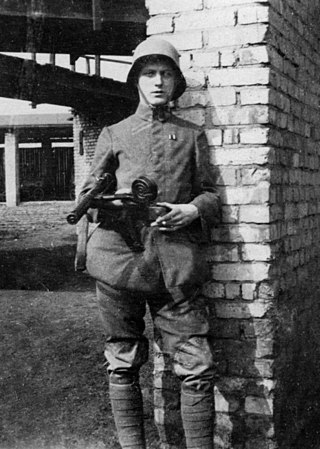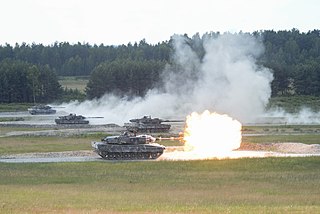Related Research Articles

Blitzkrieg is a word used to describe a combined arms surprise attack using a rapid, overwhelming force concentration that may consist of armored and motorized or mechanized infantry formations, together with artillery, air assault and close air support, with intent to break through the opponent's lines of defense, dislocate the defenders, unbalance the enemies by making it difficult to respond to the continuously-changing front, and defeat them in a decisive Vernichtungsschlacht: a battle of annihilation.
Military strategy is a set of ideas implemented by military organizations to pursue desired strategic goals. Derived from the Greek word strategos, the term strategy, when first used during the 18th century, was seen in its narrow sense as the "art of the general", or "the art of arrangement" of troops. and deals with the planning and conduct of campaigns, the movement and disposition of forces, and the deception of the enemy.

In warfare, infiltration tactics involve small independent light infantry forces advancing into enemy rear areas, bypassing enemy frontline strongpoints, possibly isolating them for attack by follow-up troops with heavier weapons. Soldiers take the initiative to identify enemy weak points and choose their own routes, targets, moments and methods of attack; this requires a high degree of skill and training, and can be supplemented by special equipment and weaponry to give them more local combat options.
AirLand Battle was the overall conceptual framework that formed the basis of the US Army's European warfighting doctrine from 1982 into the late 1990s. AirLand Battle emphasized close coordination between land forces acting as an aggressively maneuvering defense, and air forces attacking rear-echelon forces feeding those front line enemy forces. AirLand Battle replaced 1976's "Active Defense" doctrine, and was itself replaced by "Full Spectrum Operations" in 2001.

Stormtroopers were specialist infantry soldiers of the German Army. In the last years of World War I, Stoßtruppen were trained to use infiltration tactics – part of the Germans' improved method of attack on enemy trenches. The German Empire entered the war certain that the conflict would be won in the course of great military campaigns, thus relegating results obtained during individual clashes to the background; consequently the best officers, concentrated in the German General Staff, placed their attention on maneuver warfare and the rational exploitation of railways, rather than concentrating on the conduct of battles: this attitude gave a direct contribution to operational victories of Germany in Russia, Romania, Serbia and Italy, but it resulted in failure in the West. Thus the German officers on the Western Front found themselves in need of resolving the static situation caused by trench warfare on the battlefield.

Maneuver warfare, or manoeuvre warfare, is a military strategy which seeks to shatter the enemy's overall cohesion and will to fight.

Shock troops or assault troops are formations created to lead an attack. They are often better trained and equipped than other infantry, and expected to take heavy casualties even in successful operations.

Armoured warfare or armored warfare, is the use of armoured fighting vehicles in modern warfare. It is a major component of modern methods of war. The premise of armoured warfare rests on the ability of troops to penetrate conventional defensive lines through use of manoeuvre by armoured units.
Mission-type tactics are military tactics where the emphasis is placed on the outcome of a mission rather than on specific methods. Mission-type tactics have been a central component of German armed forces' military tactics since the 19th century.
Annihilation is a military strategy in which an attacking army seeks to entirely destroy the military capacity of the opposing army. This strategy can be executed in a single planned pivotal battle, called a "battle of annihilation". A successful battle of annihilation is accomplished through the use of tactical surprise, application of overwhelming force at a key point, or other tactics performed immediately before or during the battle.
Deep operation, also known as Soviet Deep Battle, was a military theory developed by the Soviet Union for its armed forces during the 1920s and 1930s. It was a tenet that emphasized destroying, suppressing or disorganizing enemy forces not only at the line of contact but also throughout the depth of the battlefield.
Force concentration is the practice of concentrating a military force so as to bring to bear such overwhelming force against a portion of an enemy force that the disparity between the two forces alone acts as a force multiplier in favour of the concentrated forces.

The Royal Prussian Army served as the army of the Kingdom of Prussia. It became vital to the development of Prussia as a European power.

The Manstein Plan or Case Yellow, was the war plan of the German armed forces during the Battle of France in 1940. The original invasion plan was an awkward compromise devised by General Franz Halder, the chief of staff of Oberkommando des Heeres that satisfied no one. Documents with details of the plan fell into Belgian hands during the Mechelen incident on 10 January 1940 and the plan was revised several times, each giving more emphasis to an attack by Army Group A through the Ardennes, which progressively reduced the offensive by Army Group B through the Low Countries to a diversion.
The Truppenamt was the cover organisation for the German General Staff from 1919 through until 1935 when the General Staff of the German Army (Heer) was re-created. This subterfuge was deemed necessary in order for Germany to be seen to meet the requirements of the Versailles Treaty. It completely revised German tactical and strategic doctrine and thereby conserved, re-energised, and unified the military thinking and capability of the Reichswehr, later to become the Wehrmacht.

The German Army was the land forces component of the Wehrmacht, the regular Armed Forces of Nazi Germany, from 1935 until it effectively ceased to exist in 1945 and then was formally dissolved in August 1946. During World War II, a total of about 13.6 million soldiers served in the German Army. Army personnel were made up of volunteers and conscripts.
Truppenführung was a German Army field manual published in 2 parts as Heeresdruckvorschrift 300: Part 1, promulgated in 1933, and Part 2 in 1934.

Ernst Volckheim was one of the founders of armored and mechanized warfare. A German officer in the First and Second World War, Volkheim rose to the rank of colonel, during World War II in the German Army. Little known outside of professional military and historical circles, Volkheim is considered the foremost military academic influence on German tank war proponent, Heinz Guderian, because both Volkheim's teaching as well as his 1924 professional military articles place him as one of the very earliest theorists of armored warfare and the use of German armored formations including independent tank corps.
References
- ↑ Hermann Cron: Geschichte des Deutschen Heeres im Weltkriege 1914–1918. Berlin 1937, p. 23.
- ↑ Corum, James S. (1992). The Roots of Blitzkrieg: Hans von Seeckt and German Military Reform. Lawrence, Kansas: University Press of Kansas. p. 30. ISBN 978-0-7006-0541-5.
- ↑ Citino, Robert M. (26 December 2007). The Path to Blitzkrieg: Doctrine and Training in the German Army, 1920-39. Stackpole Books. p. 16. ISBN 978-0-8117-3457-8.
- Cooper, M. (1978). The German Army 1933–1945, its Political and Military Failure. Briarcliff Manor, NY: Stein and Day. ISBN 0-8128-2468-7.